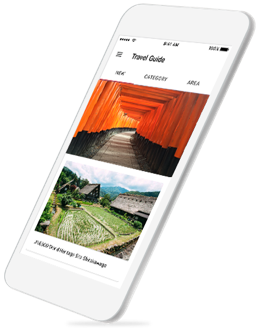JAPAN ESSENTIALS
Handy guides to prepare you for a unique cultural experience

Daily Budget
As a guideline for general expenses whilst travelling, we suggest for you to budget approx. AUD $60.00 per person / per day which will cover all food costs; lunch, dinner (when not included) and snacks. Other expenses you may incur include shopping and souvenirs etc, which are dependent on the individual.
See our guide on food-specific budgeting here.
ATMs
You can withdraw cash using your international brand credit card, debit, prepaid and cash cards nationwide at the Japan Post Bank Office ATMs, and at Seven Bank ATMs located in most 7-Eleven convenience stores. Please note that no other Japanese banks currently accept international transactions. For ATMs that accept credit cards, it is advised to contact each credit company beforehand and check the location of each ATM and its availability as these conditions vary from machine to machine. Visa provides an ATM locator on their website which you can use to locate ATMs by your nearest subway/train station.
Credit Cards
International credit cards such as American Express, VISA, Diners Club and MasterCard are also acceptable at these major establishments. However, Credit card transactions are not always convenient outside big cities so obtaining cash beforehand is recommended when you travel to the countryside.
Tipping
Individual tipping is not customary in Japan, but there are instances where hotel staff will appreciate it if personal service is provided to your guest room such as special deliveries or special requests. It is not common to tip otherwise at normal dining places.

Trains
The railway system in Japan has a reputation for punctuality and safety. Tickets for short distances are available from ticket machines that are installed at each rain station whereas tickets for long distances and reservations are dealt with at ticket offices at major stations.
Prepaid Transport Cards
‘Suica’ or ‘Pasmo’ cards are prepaid transport cards that are an excellent way to get around the city without the hassle of buying individual tickets or changing passes between train companies. They can be used on local trains in cities nationwide, and are available for purchase at the airport and major train stations. They can be topped up at designated machines in every station. More information on the Suica/Pasmo card can be found here.
Buses and Coaches
An inexpensive but lesser-known mode of intercity transportation is to take a coach. Intercity coach routes are extensive, and the coaches themselves are clean, comfortable, and can cost less than half of what you’d pay for a bullet train.
Japan Rail (JR) Pass
The key to convenient sigtseeing in Japan. The Japan Rail (JR) Pass offers an incredibly economical and flexible way to travel in Japan and is only available to overseas visitors. It’s simple to use and allows you unlimited travel on the Japan Rail (JR) network.
The Japan Rail (JR) Pass covers unlimited travel on the entire Japan Railway (JR) system including affiliated buses and ferries. Passes start from 29,650 yen for adults (Ordinary Class). Please contact your Japan Rail (JR) Pass vendor regarding eligible locations and validity.
Domestic Flights
With the introduction of Low Cost Carriers, domestic flights within Japan have become a quick alternative to long distance train or bus travel, particularly if you plan to travel to other islands in the North or South. Japan Airlines and All Nippon Airways (ANA) are our preferred carriers, but there are budget alternatives that frequently hold specials on airfares.
Luggage Delivery
If you plan to take a lot of luggage with you, to ease your load it is possible to send your large suitcases ahead to meet you at your next hotel or any residential address across the country. Fees begin from around AUD $25 per large suitcase under 25kg and can be done at your hotel concierge, at convenience stores or at the airport. A comprehensive guide to luggage delivery can be found here.
All of our tours include luggage transfer services during the tour, which will allow you to travel lighter. We ask that you prepare an overnight bag, preferably with wheels, which you are able to pack with you a two-day/overnight journey.

Mobile Phones
You can use your mobile phone in Japan with your own 3G-enabled handset after activating international roaming. For more details, please check with your local mobile phone service provider. Rental mobile phone services are also available online or upon your arrival at Narita, Haneda or Kansai Airport.
Wi-Fi and Internet Access
Although far from ubiquitous, free public Wi-Fi is becoming increasingly widespread in Japan. Free public networks can be found around major airports and train stations, tourist information centres and major shopping streets. In addition, several nationwide convenience store and cafe chains provide free Wi-Fi access to their customers, though registration is required to use most of these services, and in some cases, must be done in advance.
To remedy this, rental pocket wi-fi services are available online to be sent to your hotel or place of accommodation, or can be purchased upon your arrival at Narita, Haneda or Kansai International Airport. A comprehensive guide to internet access in Japan can be found here.
Electricity
Japan electricity operates on 100 volts, A.C. 50-60MHz, whereas Australia and Central Europe operates on 220 volts, and North America on 120 volts. Dual type electrical appliances, eg. hair dryers, travel irons and shavers will therefore be handy. The power outlets are a 2-pin-flat blade plugs, (straight up and down), similar to the US, therefore if you plan to take electronic appliances it is advisable to carry a travel adaptor with you. Transformers and plugs for three pins to convert for your electrical connections are available at some hotels.

Japan electricity operates on 100 volts, A.C. 50-60MHz, whereas Australia and Central Europe operate on 220 volts, and North America on 120 volts. The power outlets are a 2-pin flat-blade plug (as illustrated in the diagram below), similar to the US, therefore if you plan to take electronic appliances it is advisable to carry a travel adaptor with you. Transformers and plugs for the Australian three pins to convert your electrical connections are available at some hotels. Dual voltage-type electrical appliances, such as hair dryers, curlers/straighteners, travel irons and shavers will therefore be handy and may be the preferred option when purchasing electrical appliances in Japan.


Average Temperature (°C)

Peak Travel Times
Visitors to Japan should be aware of the peak times of the year for booking travel and accommodation. During these periods, you may see hotel and bullet train reservations fully booked out and if you plan to travel during these times, it may be in your best interest to make bookings far in advance.
Year-end during New Year holidays: around December 27 to January 4 and adjacent weekends
“Golden Week” holiday season: around April 29 to May 5 and adjacent weekends
“Bon” festival season: the week centring on August 15
Viewing the Cherry Blossoms
The cherry blossom (“sakura”) season begins at the end of March and generally lasts into mid-April, though it may vary from year to year. This is one of the busiest times of year for tourism in Japan, so hotel, flight and tour bookings should be done far in advance. See a comprehensive guide to cherry blossom viewing here.
Viewing the Autumn Colours
The autumn leaves (“koyo”) in Japan are a spectacle in their own right, with vibrant reds, yellows and orange signifying the approaching winter season. The best time to view the autumn colours vary depending on the region, but the main island features its best fiery colours toward mid-to-late November. Hokkaido, the northernmost island, welcomes their best autumn colours a little bit earlier, throughout October. See a comprehensive guide to autumn koyo viewing here.

Meals Budgeting
See our guide on general daily budgeting here.
A low budget lunch could cost you around 500 – 800 yen per day. Inexpensive lunch boxes are available in convenience stores and stands in railway stations and business districts. Various fast food restaurants, specialising in ramen noodles, curry, donburi or hamburgers, also offer relatively filling meals for 800 yen or less. For about 1000 – 1,500 yen, you would have a larger range of restaurants to choose from, including restaurants that offer lunch set specials for around 1000 yen.
For dinner, conventional restaurants are generally more expensive in the evening than during lunch time. Fast food and inexpensive restaurants are still available in the evening for a low budget option. Otherwise, expect to spend around 1000 – 2000 yen for a meal at a typical restaurant, excluding alcoholic drinks.
For upwards of 5000 yen per person, you will be able to enjoy dinner at an upper class restaurant specialising in sushi, French cuisine, sukiyaki, steak, or traditional kaiseki style.
Please see a comprehensive guide to Japanese restaurants here.
Travelling with Dietary Requirements
Travelling with food allergies in a foreign country can be a daunting thing. Food allergies are not common in Japan and therefore obtaining special meals or making special requests can be difficult. But don’t worry! You can still have a great time travelling in Japan; it is best to do some preparation beforehand if you feel that there will be some foods that you won’t be able to consume on your trip.
Vegetarian/Vegan Diet
Vegetarian options are becoming increasingly common in Japan due to the rising influx of tourism, but you still might need to do a little bit of research. Restaurants in tourist areas that have English menus often offer vegetarian options.
Generally, please be aware that your options may be quite limited, as many dishes without meat are made using Dashi (fish stock). Happy Cow is a great source for finding Vegetarian and/or Vegan restaurants in Japan and has an app where you can search for one in your area.
Please see a helpful guide concerning vegetarian, pescetarian and vegan-friendly food in Japan here.
Gluten-Free Diet
Following a gluten-free diet in Japan can be rather difficult as soy sauce (which contains gluten) is widely used as an ingredient in Japanese cuisine. We recommend that you pack some emergency gluten-free snacks in your suitcase – you never know when you may need them. They also help identify what foods you can rely on.
Please check carefully how your dish is prepared by carrying with you the Gluten Free Restaurant Card in Japanese, attached here.
For further reading, please see a helpful article outlining gluten-safe foods and those to avoid in Japan here.
Drink
The legal drinking age in Japan is 20 years old. Generally, alcoholic beverages are served at most eating and entertainment establishments, except for fast food restaurants. Casual drinking establishments, or izakaya, are a popular place to drink cheaply while sharing tapas-sized food with friends, and they’re seemingly ubiquitous in the cities with a shop on every corner. English-style pubs, high-end bars and nightclubs are also options for a night out in larger cities.
See a guide to alcoholic beverages in Japan and Japanese drinking etiquette here.

Asking For Help
Have no fear! The Japanese are renowned for their sense of hospitality and willingness to help. If you ever feel a little bit lost on the street, don’t be afraid to ask for help from a passerby to point you in the right direction as best as they can. Spoken English can be a little bit tricky, so writing down the address or the name of the place you need to get to and showing them may be the best way to go.
Bathing at an Onsen (Japanese Hot Spring)
Public bathing at a hot spring can be a rewarding and unique cultural experience, though it may be intimidating for first-timers. It’s important to know that having a tattoo(s) may result in refusal of entry into the hot springs, because of its association with organised crime in Japan. It is also not socially acceptable to wear any kind of bathing suit into the hot spring facility. Just tie up any long hair to avoid getting it into the water, know that everyone else is minding their own business and relax the best way the Japanese know how.
Public Transport Etiquette
In the interest of courtesy towards other passengers, please avoid speaking loudly, whether with friends or on the phone, on public transport at such as buses and trains. Public transportation, particularly in Tokyo, is also known to be extremely crowded during morning and evening peak hours, and you may need to squeeze into very close quarters with other passengers. Remember to be courteous with a ‘sumimasen’, even when you have to push.
Smoking
Although it has now become illegal to smoke on the street in many places in Japan, many bars, cafes and restaurants still allow smoking indoors in designated smoking areas, though some may not utilise proper segmentation or ventilation. It is perfectly okay to tell the service person that you would like to be placed far away from the smoking area.
Taking Your Shoes Off
Some restaurants and drinking establishments may require you to take your shoes off and place them in a locker inside. It would be best to wear socks with your shoes, or bring a pair of socks with you, as bare feet can be seen as unsightly in an eating establishment. When entering a Japanese home, you are also required to take your shoes off at the entrance.
Useful Phrases
Here are some useful phrases for your trip to Japan.
Excuse me. Sumimasen.
Do you speak English? Eigo ga hanasemasuka?
I don’t understand. Wakarimasen.
Can you please say that one more time? Mo ichido itte kudasai.
Do you have an English menu? Eigo no ‘menyuu’ (menu) ga arimasuka?
How much? Ikura desuka?
Where is the toilet? Toire wa doko desuka?
Where is the train station? Eki wa doko desuka?
I want to go to (place name). (Place name) ni ikitai desu.

![]()
Get the Japan National Tourism Organisation’s official travel app and discover more on your trip to Japan. Includes maps, embassy locations, travel tips and articles on suggested locations.
